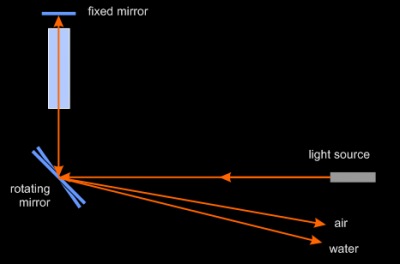
A French physicist, Jean Foucault, measured the speed of light remarkably accurately in the mid-19th century, using two mirrors set 66ft (20m) apart.
One mirror was fixed and another rotated at 800 revolutions a second. Beams of light were directed at the rotating mirror. When a light beam hit the mirror while it was at just the right angle, it was reflected to the fixed mirror, bounced back to the rotating mirror and then reflected back to the source.
In the time it took to make the return trip between the mirrors, the rotating mirror had turned through a small angle so the beam that returned to the source deviated slightly from the original path.
By using the deviation of the beam to measure the angle through which the mirror had moved, and knowing the speed of rotation, Foucault could work out how long the light had taken for its trip, and its speed. Foucault’s final result, reported in 1862, worked out at 187,000 miles a second (300,939km a second).
Foucault’s method was refine in the 1920s by Albert Michelson, an American physicist, who sent light through a vacuum tube a mile (1.6km) long to remove the effect of air on its speed. Modern measurements have refined the figure to 186,282 miles (299,793km) a second.
Picture Credit : Google
